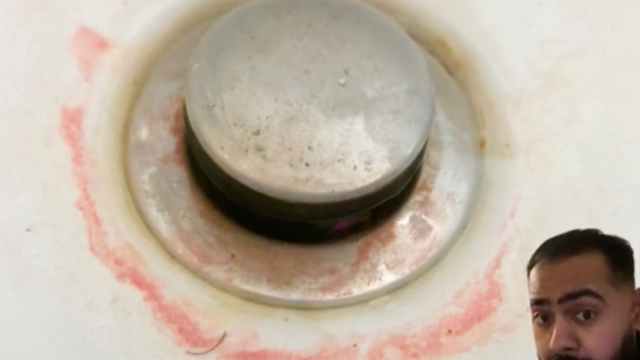“Pink Slime” in Your Sink and Shower Can Cause UTIs, Doctor Warns

We’re all guilty of turning a blind eye to the soap residue or grime accumulating in our shower every once in a while. Think about it—how many times have you thought “I’ll get to that later” only for a week to pass by without scrubbing it clean? It’s easy for this chore to slip your mind, but not properly cleaning your bathroom could be a mistake with serious health consequences, as one student recently learned the hard way.
RELATED: 5 Signs You Need to Clean Your Shower Head Before Using It Again, Experts Say.
In a video posted to TikTok, a Belfast university student revealed that her friend was admitted to the hospital after coming in contact with “pink mold” in their dorm showers. As it turns out, that suspicious pink substance has a name: Serratia marcescens. It’s actually not a mold at all, but rather an overgrowth of potentially dangerous bacteria, one doctor warns.
“If you’ve seen this pink slime lurking in your bathroom, it’s not mold. It’s bacteria,” Karan Rangarajan, MRCS, MBBS, a National Health Service (NHS) surgeon, explains in his stitched TikTok video.
Rangarajan, whose TikTok account has an impressive 5.2 million followers, says that Serratia marcescens “vomits hot pink all over” bathrooms that are extremely damp and moist, and “loves munching on fatty deposits like those found in soaps and shampoos.”
The pink bacteria is mostly “harmless” to those who are relatively healthy, Rangarajan assures. However, you should still clean and disinfect the area, while being mindful of your eyes and any scapes or open cuts you may have.
Because even if it won’t cause most people immediate harm, Serratia marcescens can pose a potential health risk for those who are immunocompromised, or if it continues to grow and spread throughout your house. Rangarajan acknowledges a few cases in which the bacteria has led to gut, urinary, and chest infections.
“If your home has enough damp for pink slime to consistently develop, you could actually be growing other things as well, like actual household molds, which could be causing respiratory issues or allergies,” he warns.
According to Taste of Home, you can clean Serratia marcescens-infested shower doors, windows, tile, and grout with a combination of 1/4 cup baking soda and a tablespoon of liquid dish soap. Scrub the infected areas with a brush, rinse, and then disinfect with a spray bottle filled with equal parts bleach and water. Let that sit for 10 minutes before rinsing.
RELATED: 7 Germiest Places in Seniors’ Homes, According to New Study.
Aside from cleaning, Rangarajan says in his video that one of biggest rules of “Pink Slime Club” is to keep your bathroom well-ventilated, so steam and mildew don’t have a chance to percolate. Keep a window open during and after a shower, and if you have a ventilation fan, that’s even better. What’s most important is keeping your bathroom dry.
The most common bathroom molds include Aspergillus, Cladosporium, Penicillium, and Stachybotrys (AKA black mold), Sophia Tolliver, MD, a family medicine physician, told Today.
“Definitely, the bathroom is a ground zero, if you will, for mold growth, probably because mold likes to grow in dark, damp areas,” she explained.
As with Serratia marcescens, many of these can be cleaned using at-home remedies. That said, if you suspect black mold to be growing in your tub, you might be better off contacting a professional.
“It’s very important that if you see this type of mold—which is usually dark green or black in color and, really, texture-wise it’s kind of slimy—that you avoid the area because if that starts to break off, the mold spores can be very harmful,” she cautioned.
As Rangarajan notes, your bathroom is “filthier than you think.”
RELATED: For more up-to-date information, sign up for our daily newsletter.